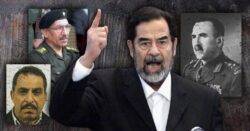Declassified files reveal British assessments of Saddam Hussein’s generals including Abdul Jabbar Khalil Shanshal (right), Nizar Abd al Karim al-Khazraji (left) and Amir Rashid (top left)
A ‘most wanted’ figure in Saddam Hussein’s high command was given lavish praise by British intelligence before the Gulf War.
Major General Amir Rashid, then an officer in the air force, was described as having ‘great drive and enthusiasm’ in a secret personality sketch.
One of the Iraqi dictator’s chief scientific advisers, he is shown to have UK links including being a University of Manchester engineering graduate in the newly declassified military intelligence document.
The assessment reveals what British officials thought of Hussein’s top brass after he ordered the invasion of Kuwait in 1990.
Some of those profiled were obscure figures at the time — while others have since managed to ‘make like the Grey Man’ after surviving Hussein’s tyrannical reign and two wars with the West.
The newly released personality sketches also give an insight into the ruthless hold of the dictator on his lieutenants.
Marked ‘secret’, the document reads: ’We have little knowledge of individual Iraqi generals; however, some characteristics seem to be common to all.
‘Iraqi senior officers tend to be young, members of the Ba’ath party of the Sunni minority, but few take religion seriously.
Amir Rashid was praised in a UK intelligence document while he was an air force commander before the Gulf War (Picture: Karim Sahib/AFP via Getty)
‘Most received their military education in the USSR and all had command experience in the war against Iran.
‘Iraqi generals are watched over by political advisers and constantly under suspicion; there are purges of senior officers about twice a year and any general who acquires a personal following or displays particular independence is liable to be assassinated.
‘Two members of the rich and influential Rashid family died in accidents in the war, the third was arrested on 28 Jul 90.’
The ‘Missile Man’ appeared in US playing cards showing wanted Iraqi figures (Picture: US DIA via Simon Moores, issuu.com/drmoores)
The entry for Gen Rashid, who would later be dubbed ‘’Missile Man’ for his knowledge of weapons delivery systems, describes him as being born around 1931 and having gained the degree and a PhD in avionics from the university. The air force’s deputy commander is credited with being the ‘driving force’ behind an effort to upgrade the wing.
The entry reads: ‘Recognised as a most able staff officer, discerning, shrewd and with great drive and enthusiasm in keeping up the momentum of ongoing projects. Intellectually head and shoulders above all other senior officers in the Air Force.
‘Much travelled and gained a reputation for being not only technically brilliant but also having a flair for financial negotiations. Headed the Iraqi team in the days when the purchase of six Nimrod aircraft from the UK seemed possible.’
Iraqi President Saddam Hussein salutes a crowd during a military parade in November 2000 (Picture: Karim Sahib/AFP/Getty)
The Interpol notice for al-Khazraji who was given only a fleeting reference in the intelligence document (Picture: Interpol)
The general is described as a married father of four in the assessment, which was produced for the UK government in February 1990 and released earlier this month by the National Archives.
The Iraqi Minister of Defence, Staff General Abdul Jabbar Khalil Shanshal, was found to be ‘courteous and friendly’.
His entry reads: ‘Respected as a good Muslim and an honest man, but not regarded as brilliant. Portly, with a pleasant, amiable and easy-going disposition. Unlikely ever to take any strong initiative in any field of activity.
‘A supporter of British training methods and practices.
‘Always courteous and friendly.’
Few details are given about other high-ranking commanders in the Iraqi military, perhaps as a result of Hussein’s regular bloody purges.
Only two sentences are given in reference to army commander General Nizar Abd al Karim al-Khazraji, noting that he was a branch member of Hussein’s Ba’ath Party in 1978.
Ominously, an entry for four arrested army officers ends: ‘Nothing more is known of their fate.’
Rashid went on to become oil minister after leaving the military.
He was reported to have retired by the time of the Iraq War in 2003, when he and his wife Dr Rihab Rashid Taha, known as ‘Dr Germ’ for her role in creating anthrax, were arrested by the US-led coalition.
Former Australian intelligence officer Rod Barton has given a colourful description of an encounter he had with an enraged Rashid in his book, ‘The Life of a Spy’.
Barton, who met Rashid while working as a UN weapons inspector before the full-scale invasion, agreed with the UK assessment — but with the following caveat.
‘I would add that he was a man that easily flew into a rage and bullied those he was in charge of — and no doubt others too,’ he said.
‘This was probably useful when he ran the Iraq missile program and later became the Minister of Oil. I don’t know where he is now or if he is still alive.
‘After the Iraq War he was held in prison longer than most of the others largely I was told because of his time as oil minister and possible hidden money.’
Rod Barton met an Iraqi general who was praised by the UK but displayed a fiery temper when challenged over chemical weapons (Picture: Rod Barton)
Rashid became the six of spades in America’s playing cards depicting the most-wanted Iraqis during the later war.
He surrendered to US-led forces in April 2003.
The former technical and scientific adviser to Saddam Hussein was said to have been quietly released in 2012, after which there is no publicly available information about his fate.
Al-Khazraji has also managed to slide out of public view after reportedly fleeing to Europe in the 1990s and joining Iraqi expatriate movements opposed to Hussein’s rule.
He is believed to have lived and sought political asylum in Denmark before slipping the net after being accused by prosecutors in the country of war crimes against Kurdish people living in northern Iraq.
His defection was mentioned in a 2011 research paper by the US Institute for Defense Analyses, which said that he was living in the United Arab Emirates at the time. An Interpol wanted notice for al-Khazraji, who would now be 84, is still live.
British personality sketches of Saddam Hussein’s generals before the Gulf War have made public (Picture: Metro.co.uk/Myles Goode)
Shanshal was dismissed by Hussein 11 months after the sketches were produced, with the then 70-year-old being replaced by a younger general who had played a prominent role in the war with Iran. After the coalition invasion, Shanshal moved to Jordan, where he died in 2014.
Fiona Galbraith, of Buckinghamshire New University, was an intelligence officer in the British Army at the time of the Gulf War.
The senior lecturer in intelligence and analysis said: ‘Armies don’t win wars, generals win wars. So just like historians like to create profiles of Montgomery and Rommel in the desert, intelligence analysts are interested in what drives individuals before the fighting starts.
‘Armies are inspired by their leaders and if the leaders are prepared to go to war, then, generally speaking, so too will their troops.
‘It’s about finding out what makes commanders tick and if they’ve got any weak spots, much like a football coach who favours a certain formation or might play certain players in certain positions.
‘As for Iraq, the generals who survived the wars would have had few options.
‘The choices would have included joining the insurgency and potentially ending up dead or in Guantanamo or trading in their secrets and making like the Grey Man in the hope of disappearing over the horizon.’
Do you have a story you would like to share? Contact josh.layton@metro.co.uk
MORE : British officials dismissed CIA ‘ghost stories’ about Saddam before Gulf War
A secret UK intelligence report provided personality sketches of Saddam’s generals before the Gulf War.





